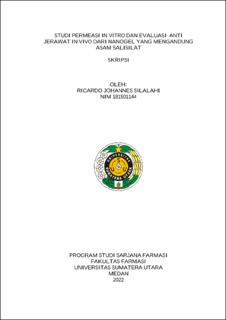Studi Permeasi In Vitro dan Evaluasi Anti Jerawat In Vivo dari Nanogel yang Mengandung Asam Salisilat
In Vitro Permeation Study and In Vivo Anti Acne Evaluation of Salicylic Acid Containing Nanogel

Date
2022Author
Silalahi, Ricardo Johannes
Advisor(s)
Arianto, Anayanti
Metadata
Show full item recordAbstract
Background: The results of previous studies regarding in vitro antibacterial evaluation tests on Propionibacterium acnes and Staphylococcus epidermidis showed that salicylic acid nanogels had higher activity than salicylic acid gel formulation. Salicylic acid formulation are used as an anti-acne topically. The anti-acne activity of topical formulation is influenced by the level of penetration into the skin. The higher the penetration, the higher its activity.
Purpose: This study aims to compare the in vitro penetration rate with concentrations of 1.0; 1.5 and 2.0% and its in vivo anti-acne activity of salicylic acid nanogel preparations.
Methods: The penetration test was carried out using the Franz diffusion cell method for 9 hours with phosphate buffer medium pH 7.4 at constant temperature (37.5±0.5ºC). Then the anti-acne evaluation test was carried out on 12 volunteers according to the inclusion and exclusion criteria. Then measured sebum levels and the number of pimples every week for 28 days with a skin analyzer (Aramo). Then the results were analyzed statistically.
Results: The results of the penetration test showed that the 1% salicylic acid nanogel had the highest penetration rate compared to the other formulation tested. The results of the penetration test were 470.76 ± 5.35 mcg/cm2. While the penetration test results of 1.5 and 2.0% salicylic acid nanogels, salicylic acid gel (1%) and salicylic acid gel formulation on the market are respectively; 386.47±4.27; 443.91±5.29; 189.42±12.01; and 460.91±5.93 mcg/cm2. Therefore, 1% salicylic acid nanogel was chosen to test its anti-acne activity in vivo that compared to salicylic acid gel (1%) and salicylic acid gel on the market (2%). The results of the anti-acne evaluation test obtained were the percentage reduction in sebum were 57.12 ± 15.20, 25.63 ± 1.52 and 42.42 ± 8.06 respectively and the percentage reduction in the number of pimples were respectively 74.05 ± 15.16 , 45.42 ± 1.54 and 57.89 ± 14.82 between 1% salicylic acid nanogel, 1% salicylic acid gel and salicylic acid gel on the market (2%).
Conclusion: Salicylic acid nanogel formulation showed higher penetration and anti-acne activity than salicylic acid gel formulation and salicylic acid gel formualtion on the market with the results of one way ANOVA statistical test with p <0.05 were 0.000 (significantly different).
Collections
- Undergraduate Theses [1834]
